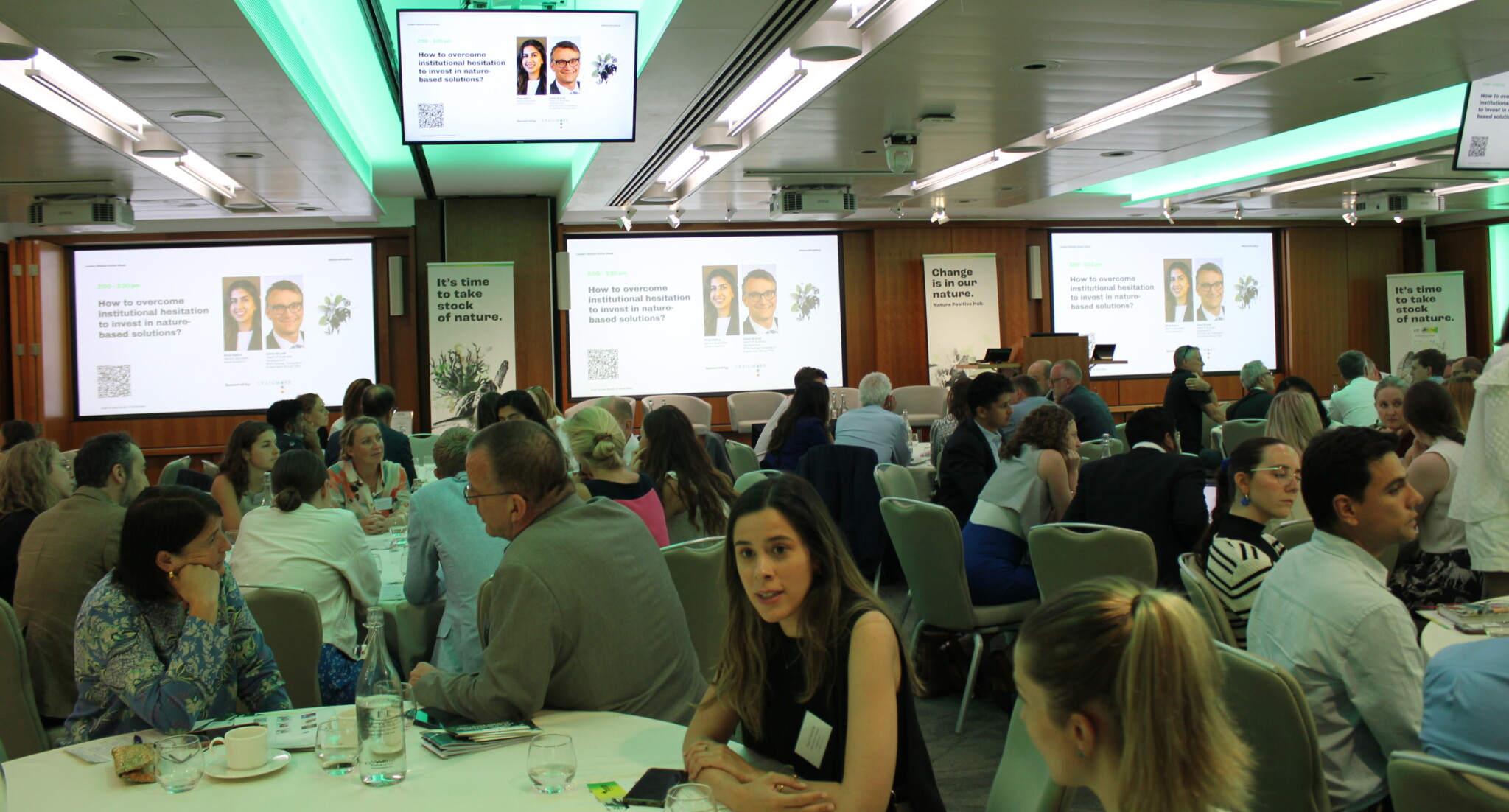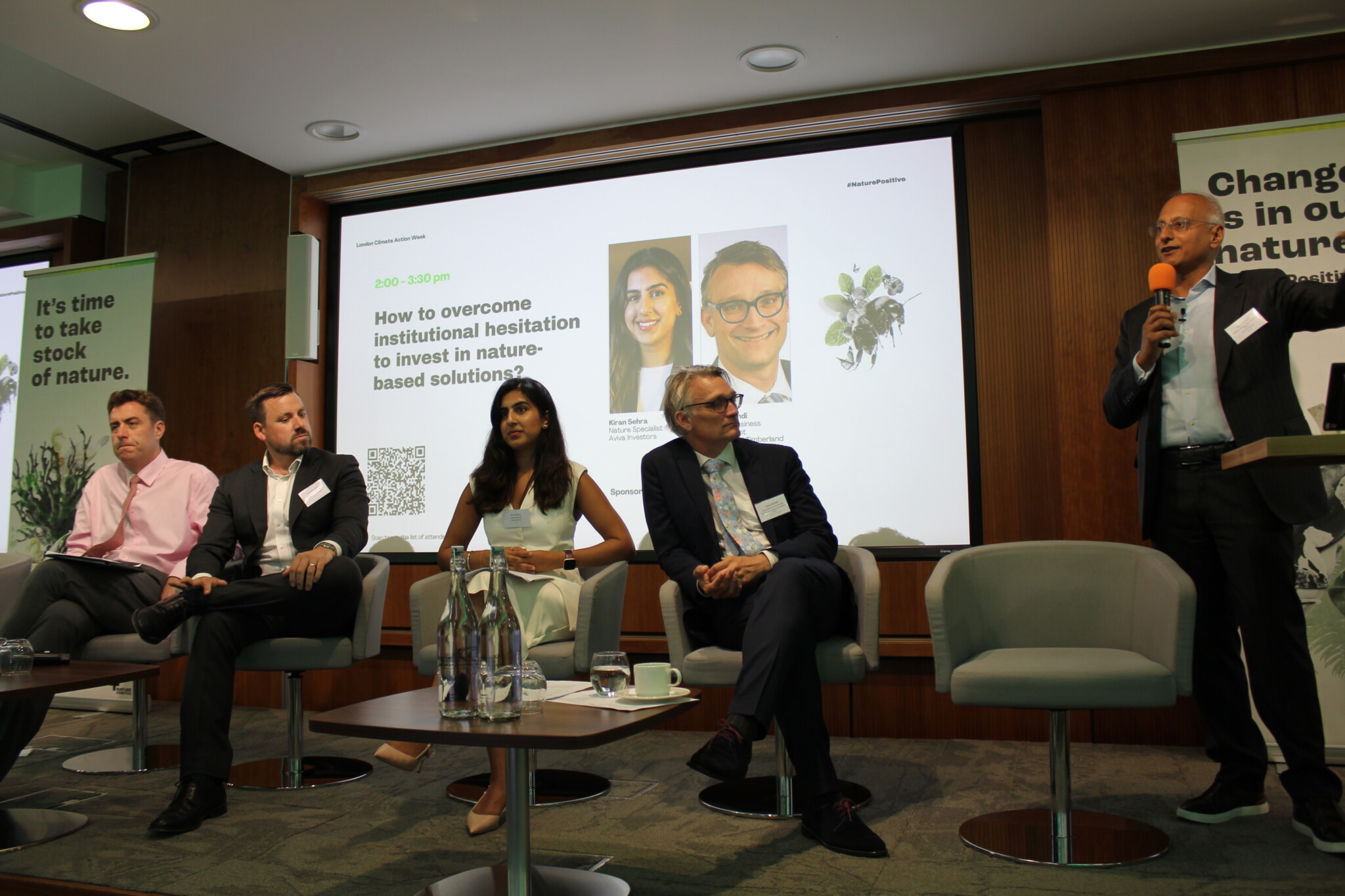
CEOs, investors, and developers of nature-based solutions debated how the private sector could transition towards a nature-positive future. Photo: Mariana Ceccon/Nature4Climate
Read more
Related articles for further reading
WRAPPING-UP
+ On June 26th, business leaders, sustainability managers, asset owners, institutional investors, and developers of nature tech or nature-based solutions joined the Nature Positive Hub at the London Climate Action Week.
+ The day’s discussion debated where the private sector should focus efforts to accelerate the transition towards a net-zero, nature-positive future. The participants also explored compelling business cases for nature, key barriers hindering progress, as well as potential strategies to surmount these obstacles.
+ Nigel Topping, the former UN Climate Change High-Level Champion for COP26, opened the event, addressing the ‘cognitive traps’ behind nature finance and investments in this area. Around 30 other experts spoke during the day.
Recognising the urgency of fixing finance flows to address societal problems such as the climate and biodiversity crises is no hard task. Currently, only 37% of investments needed to unlock nature’s potential to help meet global targets are being made available. At the same time, deforestation keeps rising, with activities that directly impact nature receiving nearly 35 times more capital than those that support recovery. This is not sustainable, all agree. The problem then lies in how to shift that system – and where to start. Should buyers be responsible for supporting nature-positive initiatives, or should investors put their energy into helping build more opportunities?
The answer to such a problem, when speaking of building a true nature-positive economy, is naturally, both. Embedding high integrity into projects, portfolios and the whole economic system can only be done with capital from buyers choosing these products instead of others that are harmful to nature. At the same time, the only way to supply this demand is by direct action of investors. Recognising the different players in the system is, however, crucial.
Overcoming hesitation and inspiring action to unlock nature finance was the headline theme of the Nature Positive Hub, held on June 26 during London Climate Action Week. Convened by the Nature4Climate coalition, the sessions gathered around 300 individuals, including business leaders, sustainability managers, asset owners, institutional investors, and entrepreneurs to discuss how and where the private sector should focus efforts to accelerate the transition towards a net-zero, nature-positive future.
Here are some of our key takeaways from each session:
How to overcome hesitation about investing in nature-based carbon credits?
“What claims will be possible from nature-based credits?” “What will be the state of the market in 2030?” “Why buy now?” Questions such as these kicked off the day of discussions, with panellists from companies like Meta, EDF Trading, Salesforce, Climate Asset Management and Bain & Company sharing how they have struggled with such uncertainty while choosing to purchase and invest in carbon credits from the voluntary market.
It was said that eligibility uncertainty is what is driving buyers and investors toward the most probable project types. This was found to have created a preference for removals over avoidance or reduction projects.
However, as one panellist pointed out, this is not because these projects are more impactful – it is always better to stop a tree from being cut than to plant a new one – but because there is greater confidence that these projects will count towards their net-zero targets in 2030.
Confusion over the different players in the market has also created what the former UN Climate Change High-Level Champion for COP26, Nigel Topping called ‘cognitive traps’ within the nature finance landscape. According to him, these include excessive focus on risk and compliance, which leaves limited capacity for talented stakeholders to devise solutions. He then emphasized the misunderstanding of carbon markets, often not recognized as a means of climate finance. This misinterpretation results in its undervaluation as a funding tool for countries and communities already bearing the brunt of the climate crisis. Lastly, he stressed the lack of pragmatism, noting that while nature is a climate solution in itself, so too are private capital providers. Their financial resources can fund the urgent conservation and restoration efforts needed for climate and nature.

The panel was moderated by Giulia Carbone, Director of the Natural Climate Solutions Alliance. Photo: Mariana Ceccon/Nature4Climate
Lack of certainty and understanding of the market is one cause of hesitation within the private sector. However, several of the panellists said they found it relatively easy to win support for nature-based projects internally due to a widespread understanding of nature and climate.
To overcome these challenges, three solutions were proposed:
- Control and involvement: Companies are showing an increasing desire to participate in the design and implementation of nature-based projects to ensure their quality.
- Positive communication: Companies should be proactive and share their positive experiences with nature-based credits to counteract negative headlines.
- Coalitions and market developments: Coalitions like LEAF and Symbiosis can help companies overcome hesitation. By collaborating, companies can enhance their understanding of nature-based carbon credits.
How to overcome systemic barriers to ensuring financial portfolios are free from deforestation-related activities?
Driving capital to new initiatives supporting nature is key to achieving global goals, but we mustn’t forget that stopping those that harm nature is ever more pressing. The second panel held at the Nature Positive Hub, focused on how eliminating deforestation from financial portfolios can be the key to simultaneously achieving nature and climate objectives, complying with net-zero targets, mitigating financial risks, and fulfilling fiduciary duties.
The session had two parts. The first, ‘Demonstrating leadership on ending deforestation’, featured representatives from Church Commissioners, Hindsight Consultancy, and ESG Integration, Federated Hermes Limited. These participants, active members of the FSDA, a group of 34 investors managing around $8 trillion of assets, aim to eliminate commodity-driven deforestation risks across investment and lending portfolios by 2025. Key takeaways included the need for simultaneous engagement with governments, companies, and policy, and the importance of initiating positive actions alongside stopping deforestation.
Annual financial flows from public and private sources, negatively affecting nature through sectors like agriculture, construction, oil, and gas, are estimated at nearly US$7 trillion, exceeding the combined GDP of the UK and India.
The second part focused on creating an enabling policy environment, with representatives from Global Canopy, The Taskforce on Nature-related Financial Disclosures (TNFD), and WBCSD. They highlighted three key trends: alignment around disclosure standards with ISSB (S1 and S2), shift from voluntary to mandatory disclosure as finance integrates deforestation into transition plans, and convergence action on climate, nature, and sustainability.
The session also marked the launch of PRI’s new investor stewardship initiative on nature, Spring, which is supported by over 200 investors managing US $15 trillion. Tim Steinweg, Head of Stewardship – Nature at PRI, announced the initiative, emphasising responsible political engagement and investor engagement with focus companies on tackling deforestation risks.

Attendees learned from pioneers, understood the risks of inaction, and discovered effective deforestation combat strategies, tools, and data.
How to overcome institutional hesitation to invest in nature-based solutions?
‘We only get one shot at this’. Urgency in making the right choices for nature and climate across the different opportunities and sectors marked the third session of the Nature Positive Hub at LCAW. Representatives from Bank of America, AXA Investment Managers, Schroders, Aviva Investors, and BTG Pactual TIG, who have collectively allocated over $3bn into nature-based solutions, discussed the opportunities and challenges to scale investments in nature to achieve global goals.
Building from previous discussions, there was a consensus among the panellists that investments in nature need to be considered alongside efforts to identify and move existing investments with deforestation-related impacts. In their experience, internal cultural hesitation to invest wasn’t a particular challenge, reflecting an 11x increase in nature-positive finance in recent years.
However, they pointed out that investments in this sector are nascent and key issues to deliver them at scale often revolve around risk, reward, and liquidity.
Forestry investments earned the spotlight as the ones offering the best risk and reward profile and scalability of investment opportunities. Having an existing asset class attached to an investment, such as forestry or agriculture, was seen as beneficial for attracting capital, particularly from institutional investors.
There was also a strong call for more certainty in carbon markets. As investments are long term and institutions are risk averse, this certainty would help unlock significant additional capital. Jurisdictional regulation and floor prices were discussed as potential solutions, but so were demonstrable large-scale transactions in the carbon market.

Representatives from Bank of America, AXA Investment Managers, Schroders, Aviva Investors, and BTG Pactual TIG composed the panel aimed at looking into the opportunities and challenges to scale investments in nature to achieve global goals. Photo: Mariana Ceccon/Nature4Climate
How can nature tech help the private sector meet its climate and nature goals?
Are the merging technologies for nature applicable? Can they deliver the scale needed to change the game on nature and climate? The fourth and final session of the day brought nature tech companies and their clients to answer these questions. Mark Gough of Capitals Coalition welcomed a diverse group of nature tech speakers from Earth Blox, Cultivo, Pachama, and SEED, as well as private sector partners from BCG, Salesforce, Citi Global Data Insights, and Octopus Energy to showcase examples of how technology can support stakeholders to achieve their climate and biodiversity goals.
The event was a showcase of genuine, practical collaboration. It featured four pairs of speakers, each a combination of a nature tech entrepreneur and a private sector client, who shared their joint efforts, actively combining their skills to make a tangible impact on nature and climate. Here are two examples of how these collaborations are currently using nature tech:
- Remote monitoring: For a private company with a vast number of sites or dependencies, on-ground nature monitoring is not always feasible. They require a remote solution for accuracy and comprehensiveness. Satellite sensing can provide just that. One pair of speakers discussed how satellite imagery can provide scalable analytics, customised to a company’s needs. When the company began collaborating with a private-sector data science team, they tackled nature from a risk control and assessment perspective. By overlaying historical and current satellite data, they could visualise the company’s impact on a grand scale. This approach transformed a ‘nature problem’ into a ‘data problem’, making it relevant to a private sector boardroom.
- Project selection and monitoring: A private sector partner highlighted the challenges of selecting and monitoring nature-based carbon credit projects. As their purchasing criteria evolved, they joined forces with a nature tech provider. Together, they conducted a thorough project due diligence process, going beyond a project’s registry accreditation. Using remote sensing technology, they ensured the accuracy of credit projections and the project’s adherence to major milestones. The technology could reveal if saplings were planted on schedule or if any illegal logging had occurred within the project area. It could also analyse various data points, including the levels of carbon revenue sharing with local people and a project’s contribution to the UN SDGs, further mitigating risk for their private sector partner.
The nature tech panel proved that high-quality data is being generated and available in the market. The next step, accordingly with the panellists, is to foster more collaborations with the private sector to convert these insights into action.
The Nature Positive Hub was hosted under the Chatham House Rules. We would like to thank our sponsors Global Canopy, Space Intelligence, Cultivo, Craigmore, Calculus Carbon and TIG for supporting the Nature Positive Hub.